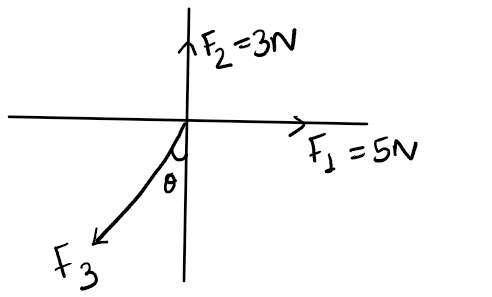- Forces and Vectors: force table is shown below as well as a free body diagram. F,-5N on, and F-3N and points in the +y-direction. We can use vectors to represent
- Forces and Vectors: force table is shown below as well as a free body diagram. F,-5N on, and F-3N and points in the +y-direction. We can use vectors to represent
College Physics
11th Edition
ISBN:9781305952300
Author:Raymond A. Serway, Chris Vuille
Publisher:Raymond A. Serway, Chris Vuille
Chapter1: Units, Trigonometry. And Vectors
Section: Chapter Questions
Problem 1CQ: Estimate the order of magnitude of the length, in meters, of each of the following; (a) a mouse, (b)...
Related questions
Question
Can you show me how to solve it and set it up. I got the equation and formula wrong.

Transcribed Image Text:We can use vectors to represent forces. A top-down
Problem 4- Forces and Vectors:
view of a force table is shown below as well as a free body diagram. F,-5N and points in the
*x-direction, and F,-3N and points in the +y-direction.
F2
F2 3N
F1 5N
F1
F3=?
-1
A.
What force (F,) is required to bring this system to equilibrium? (Recall that the
X-component of this force is equal to F, and the y-component is equal to F,)
T 2+2
3-5 =-2
F>
7 T-T.
F3 -2
B. At what angle (labeled 0 in the diagram) must the force be placed in order to
bring the system to equilibrium? (Recall that the inverse tangent function can be used to
calculate the angle given the x- and y-components).
Expert Solution
Step 1
We have given the three forces as shown in the figure
F1 = 5 N , toward +x axis
F2 =3 N, Toward +y axis
F3 with the angle shown in the figure

Trending now
This is a popular solution!
Step by step
Solved in 3 steps with 2 images

Knowledge Booster
Learn more about
Need a deep-dive on the concept behind this application? Look no further. Learn more about this topic, physics and related others by exploring similar questions and additional content below.Recommended textbooks for you

College Physics
Physics
ISBN:
9781305952300
Author:
Raymond A. Serway, Chris Vuille
Publisher:
Cengage Learning

University Physics (14th Edition)
Physics
ISBN:
9780133969290
Author:
Hugh D. Young, Roger A. Freedman
Publisher:
PEARSON

Introduction To Quantum Mechanics
Physics
ISBN:
9781107189638
Author:
Griffiths, David J., Schroeter, Darrell F.
Publisher:
Cambridge University Press

College Physics
Physics
ISBN:
9781305952300
Author:
Raymond A. Serway, Chris Vuille
Publisher:
Cengage Learning

University Physics (14th Edition)
Physics
ISBN:
9780133969290
Author:
Hugh D. Young, Roger A. Freedman
Publisher:
PEARSON

Introduction To Quantum Mechanics
Physics
ISBN:
9781107189638
Author:
Griffiths, David J., Schroeter, Darrell F.
Publisher:
Cambridge University Press

Physics for Scientists and Engineers
Physics
ISBN:
9781337553278
Author:
Raymond A. Serway, John W. Jewett
Publisher:
Cengage Learning

Lecture- Tutorials for Introductory Astronomy
Physics
ISBN:
9780321820464
Author:
Edward E. Prather, Tim P. Slater, Jeff P. Adams, Gina Brissenden
Publisher:
Addison-Wesley

College Physics: A Strategic Approach (4th Editio…
Physics
ISBN:
9780134609034
Author:
Randall D. Knight (Professor Emeritus), Brian Jones, Stuart Field
Publisher:
PEARSON